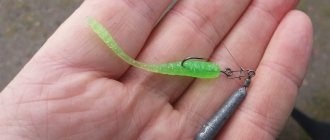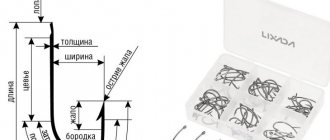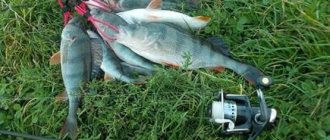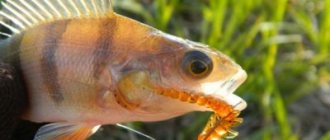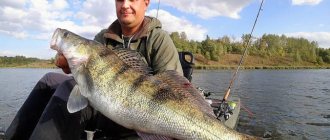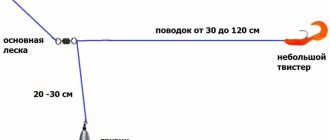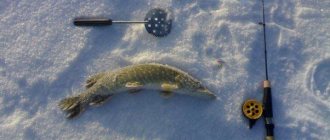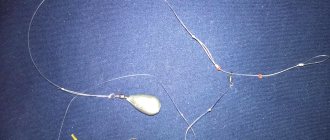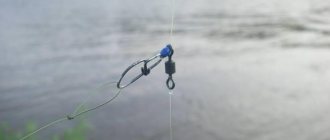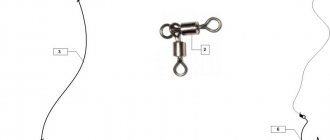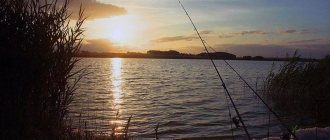Mounting options
Solid installation
This is the simplest installation, when the load is attached to the end of the main line, and above it, at a distance of 20-30 cm, a loop is formed, to which a leash with a hook is attached.
More complex ways
The design of securing the load and leashes can be modified. A double swivel is attached above the secured load. The leash is attached to this swivel.
Alternatively, you can attach a triple swivel so that the main line, leader and sinker are attached to each eye of each swivel. This is not a bad option, especially if you have to fish in the current. The presence of swivels prevents the equipment from twisting, and if it gets caught, you can lose one thing.
Sliding installation
This installation is a mirror image of the previous one, since a leash is attached to the main line, and the weight is located on a separate leash, which slides along the main line. The length of the leash is selected within 20-30 cm. To do this, you need to take the swivel and place it on the main fishing line. A leash is attached to the same swivel, at the end of which another swivel is attached, to which a load is connected. On the main line, below the swivel attachment point, you need to install a stopper.
This installation method allows you to swap the load and the leash. And yet, such equipment has its drawbacks: when casting, the load will always fly first. To limit the sliding of the load along the fishing line, install another stopper above the attachment point.
How to make a diverting leash. Catching equipment
Elements of the diverter leash equipment
Spinning
Such equipment is characterized by the fact that the bait is always in a suspended state and it is difficult to control its play. In this case, it is necessary to have a very sensitive rod with a fast action. Only with the help of such a rod can you understand how the bait behaves.
If fishing is carried out from a boat, then a rod with a length of 2 to 2.4 meters is sufficient. When fishing from the shore, it is better to take a rod up to 2.7 meters long. The spinning test is selected depending on the fishing conditions, or more precisely on the weight of the load. If there is a current, then you will need a solid load, weighing up to 70 grams, or even more. Accordingly, the rod test is selected.
It is advisable that the weight of the rod be minimal, otherwise you will not get any pleasure from the fishing process. This is due to the fact that fishing with a spinning rod requires constant monitoring of the gear. This means that the rod is constantly in the hands of the spinner. A rod that is too heavy will quickly lead to arm fatigue.
Coil
The reel for the tackle is selected depending on the size and characteristics of the fishing rod. There are no special requirements for it. The main thing is that the reel is reliable and can withstand constant casting.
Main line
It is advisable to use braided fishing line, as it does not stretch and will be able to transmit the slightest bites to the tip of the rod. Its diameter depends on many factors, such as the presence of a current, the weight of the load, and the size of the catch. When fishing in the current, it is better to opt for braided line. It is stronger, which means you can use a fishing line with a smaller diameter to create less resistance to the flow.
Leash
Retractable leash (Moscow equipment)
To make a leash, you can take regular monofilament fishing line. Its breaking load should be less than the breaking load of the main line. This is necessary so that in case of a snag you do not have to lose your equipment.
At the same time, it should be remembered that monofilament fishing line has memory, so it is used for one time only. For your next fishing trip, it is advisable to tie the leashes using fresh fishing line.
Recently, almost all anglers have been using fluorocarbon as a leash. It is not visible to fish in the water, and it is somewhat stiffer than monofilament, which leads to less overlap during casting.
The size of the leash for the load is 20 or 30 cm, the size of the leash with a hook is from 50 to 150 cm. Its diameter is selected in the range of 0.16-0.2 mm. If there is a high probability of a pike biting, then it is better to put a metal leash.
Silicone baits
Lures can be made from regular or edible silicone, into which attractants are introduced during its production. The choice of such baits is so large that it is difficult to settle on just one choice. The use of edible rubber is especially important when fishing for perch. In general, if there is a choice, it is better to give preference to edible rubber.
Hook
When using equipment with a retractable leader, the same hooks are used as when fishing with a jig. If the bottom is clean, then you can use ordinary hooks that have a long shank. If there is a possibility of snagging, then it is better to take offset hooks and mount non-snagging hooks.
Equipment and installation of the outlet leash
You can make a diverter leash directly while fishing, but it is better to take care of ready-made installation of the equipment at home.
Use braided line
for better rig sensitivity. It does not stretch when pulled and allows you to transmit any pokes from the fish, as well as better probe the bottom. The diameter depends on the intended catch; beginners are advised to take a fishing line with a diameter of at least 0.12 mm (braid), it will withstand 8 kg of direct load, and is also much less tangled.
A sinker is tied to the end of the fishing line.
Sinkers are most often used weighing 15-30 grams of pear-shaped, Cheburashka or Tyrolean sticks (which are protected from snagging in soil strewn with large stones).
The weight is selected depending on the depth at the fishing spot and the desired casting distance. An ideally selected sinker allows you to make long casts, and after falling to the bottom after 3-4 turns of the reel, it must rise from the bottom and not drag along it.
A leash 1 meter long is tied 30-40 cm above the sinker.
This leash is made from monofilament or fluorocarbon line. The advantages of these lines are their low visibility and a predator will undoubtedly attack a moving bait. Fluorocarbon fishing line is preferable, but has its drawbacks in terms of low breaking load.
A leash is tied at the end of the fishing line
either a swivel with a clasp for conveniently changing the bait (it is advisable to use small swivels), or the bait directly.
A triple swivel (carabiner), which can be purchased in a store, will help you connect all three pieces of fishing line (main line, 30 cm lead to the sinker, and 100 cm lead to the bait). In addition to being less tangled, it will save you from twisting the line, and the equipment will also become more convenient in terms of transportation.
Types of sinkers
The rig can use various forms of sinkers, depending on the nature of the bottom of the reservoir.
Bullet
This type of sinker is quite similar to a bullet. Under certain conditions, the bullet can withstand most hooks.
Drop shot
This is a special type of sinker designed specifically for drop shot rigs. This is an elongated weight, to the end of which a fishing line is attached. A special type of fastening allows you to very quickly increase or decrease the distance to the hook.
Tyrolean stick
In such a rig, a Tyrolean stick can serve as a load. This is a hollow tube, at one end of which a load is attached, and the other end is hermetically sealed and serves as a fastening for the fishing line. Once in the water, it takes on a vertical position, as a result of which its permeability increases. This factor also helps to reduce the number of hooks and hold the bait at a certain height from the bottom. The technique of fishing with a Tyrolean stick is very unique and requires certain skills. And, nevertheless, the Tyrolean stick is quite catchy.
Long
Here the weight is pear-shaped, which allows you to throw the bait quite far. Carp anglers very often use a load of this shape.
Lures
The main type of bait that is ideal for fishing with a retractable leash is considered to be silicone. There is a huge selection, depending on color, size and purpose. The most suitable are twisters, vibrotails, worms and fish. Although it is possible to use other baits that imitate various crustaceans, bugs, etc. Recently, silicone baits have been used so widely that it seems as if other baits do not exist.
Sometimes, but very rarely, light, rotating or oscillating spoons are used. Equipment with a retractable leash involves the use of very light baits, so spoons and spinners are practically not practiced. It is practiced to use artificial baits such as flies, which have minimal weight, which allows them to be suspended in the water column. Moreover, you can catch any fish with flies, not just predatory ones.
Fishing with a retractable leash (wiring)
The diverter leash for pike perch, pike and perch works according to the same scheme and there is no difference in their structure.
When fishing from the shore, most often the equipment is thrown to the maximum distance. In this case, it is advisable to take into account the nature of the bottom and avoid fishing in highly snug places, since the entire fishing process involves tapping the bottom with a sinker, followed by a meter-long leash with bait.
After the bait falls into the water, wait until it reaches the bottom; with the line taut at the tip of the rod, you will feel a weakening - it’s time to make a small reel. Rewinding can occur either slowly or quickly, but with stops. Most often this is 2-4 turns of the coil and stopping for a few seconds.
During stops, your line should be taut and if a bite occurs, hook it immediately. The pike perch has a very strong jaw, which cannot be caught with a light hook.
During retrieving between pauses, you can play with the tip of the rod, thereby giving even greater vibration to your bait.
See how a professional fisherman wires a lead rig with a twister.
A retractable leash is more promising than standard jig tackle in that the likelihood of the bait getting caught is much lower, because it is more often in the water and not on the bottom. The action of the bait is also not constrained by a heavy load.
You can use several baits and several leashes in a rig. The next leashes should be shorter than 1 meter and located at a relative distance from the first one so as not to catch each other.
The success of fishing greatly depends on correct wiring. In bad weather, sluggish fish prefer slow-moving prey, take this into account.
Comments
Is it possible to catch pike this way? and what test is needed for a spinning rod?? and what is better to use fishing line or thread?
The spinning rod test should be 40-120 grams and it is better to use braid.
Will regular silicone with a jig work?
For fishing with a retractable leash, it is better to use braided line, since fishing takes place at depth and you need to tap the bottom with a weight. No stretching is very important here.
I don’t know what you mean by ordinary silicone. Twisters and vibrating tails without a jig head are suitable. It is still better to use a weight in the form of a pear or a tube (without a hook, of course) - so that there are no snags.
thanks a lot !! and one more question!! but what if the pike walks on the surface??how to do the wiring??
and another question: if the reservoir is no more than 25 cm, is it possible to fish there?
If the depth is shallow, then a diverting leash is not needed here - use wobblers, ranoutrom.com/sposoby-lovli/shhuka/rybalka-na-voblery.html here is about choosing wobblers for pike and correct wiring.
If you are sure that there is a pike in the reservoir, then you can catch it.
The spinning test primarily depends on the size of the bait. In principle, from 15 to 40 is quite good for a lead and jig fishing. Naturally, you can catch pike. Take only larger baits and experiment with colors. In one weather and place it will be taken with dark or natural colors, on another day and in another place - with fluorescent baits.
Do you need a carbine for a silicone fish? (regular) or should it not spin?
Alexander, do you mean vibrotail? It is better to use a swivel, especially when fishing with a twister. Without a swivel, the equipment will still twist, regardless of how the vibrating tail behaves in the water.
It is better to install a three-way swivel in the place where the diverter leash is attached - there will be less confusion.
And if you put small carbines everywhere, then the tackle turns into an easily dismountable and easily transportable option. Plus, if you are fishing for perch, try a small unshipped perch spinner instead of silicone...also a cool option.
I read a lot of good advice. Thanks for the detailed descriptions. Happy fishing everyone. Ladoga)))
And what kind of lures are needed for catching pike, I used all the wobblers but none of them helped. Young man, help me and tell me how and what bait I should use to catch this pike. Help.
Great info, thanks a lot
I fish with edible rubber, it’s a little expensive, but it all pays off with interest...
Oleg, why is this here?
I do the installation as follows: the main one, put the smallest swivel on it in one ear, then the same swivel in both ears of the main one, two turns each so that it slides along the main one with a weight at the end
When fishing, the swivel moves towards the leash, respectively, thereby also reducing the risk of getting caught in the load and losing the trophy. I only use monofilament. The river has 70-90 meters of driftwood. I carry a kilo of weights and bait with me. But the result is not bad at times.
It can be done easier by using float stop beads, two or three pieces in a row, depending on the expected size of the fish when biting. Then, when hooking, the leash moves towards the sinker and the fishing process improves significantly.
What is the best way to catch herring?
Retractable leash catcher when the sinker walks along the main line
Very informative, thanks to the author! I tried a retractable leash in the summer, it is much more effective than a jig in terms of the number of fish. Have you tried fishing with a retractable leash in late autumn, or even in autumn at all, will it bite?
I fished with a leash from May to November, catchy and simple tackle, and edible rubber on the underwater increases the number of bites.
I catch Bass using all sorts of perch methods...thanks for the advice...Perch or Bass stopped biting in November, maybe a retractable leash will help...we'll try! !!
I didn’t catch any bass, but the perch pecked until the ice on the outlet.
I want to see how they fish with a wobbler on the lake and a sinker
The effectiveness of fishing with a retractable leash directly depends on how well the gear is assembled. This does not mean that you need to buy a specialized fishing rod, the most expensive reel and prestigious braid. Some fishermen even manage to remake a jig tackle in a few minutes, adjust it to this spaced equipment right on the pond, and then enjoy successful fishing.
Methods for attaching a leash
There are several options for attaching the leash to the equipment. For example:
- Using the “loop-to-loop” method. A loop is formed at the end of the leash, which is threaded through the loop on the main fishing line, after which a hook is threaded into the same loop. Finally, the connection is tightened. The disadvantage of this option is the fact that it is impossible to quickly change the leash. Despite this, there are no problems with removing the leash.
- Attaching the leash using a swivel. This method allows you to minimize overlaps.
- Fastening the leash using a clasp (carabiner). This is the most progressive option, allowing you to easily change the leash to a new one, since very often you have to experiment.
What kind of fish can be caught on a retractable leash?
It is believed that a rig with a retractable leader is the most effective for catching perch. Despite this, other fish, not only predatory ones, are caught on the diverting leash. Here everything depends on the nature of the bait, since you can put both artificial and natural baits on the hook.
Perch fishing
Most spinning anglers use a retractable leash to catch perch. Edible silicone is used as nozzles as it is more catchy. As a rule, twisters, worms or vibrotails are used, but as practice shows, crustaceans or beetles made from the same silicone are no less catchy. As for the color scheme, you will have to experiment here.
For catching standard-sized perch (medium), baits measuring 2-3 cm or larger are suitable. A large perch can easily attack a worm up to 12 cm long. The length of the leash is also selected experimentally and can be from 1 meter to 1.5 meters in length. Sometimes a leash length of 30-40 cm is enough. With such equipment you can catch perch throughout the daylight hours. Perch can be found near holes or on riffles, as well as on the border of two currents.
Fishing for pike perch
Pike perch, which lead a bottom-dwelling lifestyle, can also be successfully caught using a rig with a retractable leash. The only thing is that you need to use powerful offset hooks that are quite sharp. This is due to the fact that the pike perch’s mouth is strong and can only be penetrated as a result of a decisive hook.
Pike fishing
Pike can also be caught using a retractable leash, but measures must be taken to ensure that it does not bite off the bait. To do this, a metal leash up to 30 cm long is added to the main leash. Silicone is used as bait, in the form of twisters or vibrating tails, up to 8 cm long. As for their colors, it is better to experiment to find out the preferences of the pike.
What kind of fish can be caught on a retractable leash?
A retractable leash is preferable for catching predatory species:
- zander;
- pike;
- perches.
Let's take a closer look at the features of catching these fish.
Pike
When fishing, the main thing is that the leash on the fishing line is sliding. When using a metal structure as a diversion leash up to 37 mm in length, it is preferable to catch toothy pikes in winter. For bait, use vibrating tails 4-8 cm in diameter. The color of the bait can be almost any. The main thing is to learn how to play with it when landing fish.
Zander
When fishing, spaced equipment is required. Successful fishing with a jig using a blind lead.
The main thing is to use powerful and sharp offset hooks, but not to make sudden and powerful movements when hooking, otherwise you can simply pierce the pike perch’s mouth.
As for bait, it is appropriate to use a jig so that the bait slides along the fishing line, thereby playing and being attractive to a given predator. When installing to the fishing line you need:
How to catch more fish?
I have been active fishing for quite some time and have found many ways to improve the bite. And here are the most effective:
- Bite activator. Attracts fish in cold and warm water with the help of pheromones included in the composition and stimulates its appetite. It’s a pity that Rosprirodnadzor wants to impose a ban on its sale.
- More sensitive gear. Reviews and instructions for other types of gear can be found on the pages of my website.
- Lures using pheromones.
You can get the rest of the secrets of successful fishing for free by reading our other articles on the site.
- attach a weight, a foam ball and a triple swivel;
- attach them to the main cord of the fishing line at an angle of 90 degrees;
- tilt one ear to the side;
- attach a leash up to 120 cm long to it.
Perch
This fish is also well caught on a retractable leash, and silicone baits are suitable as bait:
- Twisters.
- Vibrating tails.
- Worms, different in color.
Perch is not constant in different fishing seasons, so it is best to use baits of various colors, sizes and shapes in order to achieve good results. In addition, it is important to consider fishing conditions. This fish is often attracted to small baits in the form of worms and spiders. The leash should be up to 1.5 m long, since perch is a capricious fish and the length of the leash should be well adjusted to a shorter or longer direction.
It is better to catch perch on a retractable leash in the morning or in the evening, when the predator begins to emerge from its hiding places. It prefers the boundaries of currents and rifts.
Of course, perch are smaller in size than pike perch and pike perch, so installation of the diverter leash should be more delicate. During production you will need:
- carabiner (2 pcs) in the shape of a cylinder;
- fluorocarbon leader;
- silicone
To make gear you need:
- Pass the swivel through the main line so that it slides freely along it.
- Tie another swivel to the main cord.
- Pass a fairly strong fishing line through the free eyelet with a length of up to 37 cm, so as not to break at an unnecessary moment.
- Pass the sinker through the fishing line so that it slides freely along it.
- Tie the ends of the fishing line with a knot to create a loop for attaching the swivel and sinker later.
- Tie another swivel to the fishing line and a leash to the free eye.
- Attach a silicone with an offset hook to the leash, hanging a pellet on it.
Bait selection
Lures for zander, pike and perch are suitable:
- jig;
- elastic bands;
- twisters;
- attractants, i.e. any odorous with the possible addition of edible elements to better deter fanged predators in one place.
You need to choose bait taking into account the terrain and color of the water. It is better to use bright acid colors for silicone baits.
For example, wobblers and floating suspenders are suitable for fishing on the surface. Spreaders and spinners will be effective even in the absence of bites.
Often, purchased silicone baits are impractical and rotate around their axis to no avail. It is important to first check their performance, otherwise they will only lead to trouble on the water. You can use lead pellets to make the rig more stable when rotating.
Simple soft baits, which are used for different methods of fishing, are suitable for a retractable leash. There are no special requirements for them. The main thing is that they are mobile, small in size, reliable and firmly attached to the main body of the fishing line.
The colors of the baits can be any. These are the individual preferences of the fisherman.
It is best to have a whole range of baits on hand, both bright and calm tones.
Types of wiring using a branch lead
Wiring to the outlet leash. Fishing technique with a retractable leash. Wiring.
The game of bait may differ from various accepted standards and may not be systematic.
Dragging along the bottom
This is one of the simplest and most effective wiring, when the load is pulled along the bottom. By keeping the line taut, you can make sure that the current does all the work of playing with the bait. As for standing water, everything is somewhat more complicated. A load that will raise a cloud of turbidity behind it will certainly interest a predator. In addition, it will make characteristic noises.
Dotted line animation
This type of wiring is characterized by the presence of tension and pauses. The duration of tensions and pauses is established experimentally during the wiring process. Alternatively, you can use a classic jig step. The alternation of these elements resembles a dash-dotted line.
Aggressive jerky wiring
While fishing, if no fishing methods work, you can try aggressive jerking movements using a rod. When organizing pauses, it is advisable to animate the bait with subtle movements of the rod tip.
Winter fishing for pike perch and bersh using a retractable leash.
Disputes about “catch-up” (leash equipment) have not subsided, probably since the advent of this type of installation. For some winter fishermen, when fishing for pike perch, an additional leash with a hook, petal or phosphorus jig above the main bait is an integral part of the equipment. Others cannot stand such installations, arguing that this is all a thing of the past and that the lead installation leads to frequent snags, entanglements, and twists, and this, in turn, affects the fish gatherings and the general mood of the fisherman. I am closer to a slightly different point of view, in which at the same time both are right in their arguments, but in certain moments. These are the points that will be discussed in this material.
Indeed, a winter diverter leash can cause trouble when:
1. Fishing for pike perch or bersh takes place in a strong current.
The fact is that when reeling out the equipment while biting on the lower bait (jigs, jigs, jigs), even a very short leash, which is located above the spoon, will be blown by the force of the current under the ice and cling to the edge of the hole. At the moment of hooking, the fishing will stop, and in order to continue fishing, you will need to give the line slack, then the fish on the lower tee will twitch and the hook will unhook from the ice. Here the situation can develop in different ways. Either, after the fish has helped to unhook the upper “petal” with further fluttering, it will continue to help the angler and allow itself to be led into the hole, or the hook will follow again, or, having given the predator some slack, it will be able to turn around and free itself from the hook.
2. The leash is not compatible with the type of spoon used.
According to their play, spinners are divided into several types: jigging ("Swedish Pimple", "Halko", etc.), falling ("Dancer", "Tulka", etc.), gliding ("Williams", "Little Cleo" " and so on). Many people, especially beginning pike-perch fishermen, make the fatal mistake of tying a retractable leash above any spinner. Yes, what can we say about spinners, when some winter fishermen try to “catch up” even above the balancers, in the hope that the additional hook will have a positive effect on the bite. But the realities of the underwater world are as follows: - any, even the lightest “petal” disrupts the game, the balancers, the falling and gliding spinners. During the animation, the bait no longer makes the correct movements, and this alarms the pike perch, it stops paying attention to it and simply leaves from under the hole.
3.The length of the bend is large.
On the one hand, it seems that a long “divert” with a jig should have a positive effect on the bite, because the jig, carried away by the force of the current, will constantly sail just above the bottom, making some chaotic movements there that will interest the predator, even if the bottom (heavy bait) ) will lie motionless on the bottom (stand-up fishing). But, in practice, it is the long leash that often twists around the main fishing line and almost constantly clings to the ice when pulling out the tackle.
4.Additional knots on the main line reduce its strength, which in turn can lead to the loss of the trophy.
Here are four significant reasons that are enough to once and for all abandon the use of an additional hook on gear for catching pike perch and bersh.
Now let’s try to rehabilitate the leash (retraction) and give several arguments in defense of the “grandfather’s tackle”!
Even a beginner knows that both pike perch and bersh are unpredictable predators. In the morning, the fish was caught perfectly with a spoon without any “catch-up”, but literally an hour later it began to just “hang”, tossing the spoon, knocking down the sprat and not wanting to be caught. The striped robbers changed their mood, became suspicious or lay low, not wanting to react to the active play of spinners or balancers.
There are several ways out of this situation. You can start searching! Walk, drill, search, remove the most aggressive predator from every fifth (or even tenth) hole, then continue to “dig” the endless expanses of the reservoir. But what to do if the ice is already under the drill handle? You can get together as a friendly group and chat over a cup of “talking water”, discussing the current situation, or you can try to switch to passive fishing using a leash.
Passive zander - a small passive bait! And what could be better than the old proven “petal”?
Let's together make a challenge the way I see it and try to serve it under the noses of the capricious, fanged and bearish.
Conservatism in winter fishing is not always a bad thing. You need to notice little things and adapt to the mood of the predator. Fishing tactics on a particular day may depend on many factors, but, in my opinion, a couple of ready-made leashes with baits of different weights do not drag down the backpack, and such an installation works quite often.
There are days when, wherever there is a storm, only bersh bite, and here the installation of a mormobles with a leash is always in the first place for me. In addition, the diverting leash shows itself perfectly when the pike perch lies on the bottom. At such moments, fishing a light jig with a phosphorus jig downstream very often helps to continue fishing where others have already despaired of catching anything, while most of the “fanged” bites are always on the “petal” (outlet). Most likely this happens because the light jig continues to sway even when the main bait has already frozen at the bottom, this is a provocative moment that forces the predator to attack.
With a short pull and careful fishing, hooks happen extremely rarely, and dealing with such situations is quite simple - you just need to have a spear on hand for installing summer fishing rods, with which you can quite easily unhook the “petal”.
Other related articles:
Pike perch fishing in winter. Part 2 (animation of baits) - this article discusses methods of jig animation that can and should be used when fishing with a retractable leash.
Catching pike perch and bersh in winter with a jig - a few words in defense of passive baits.
NHNCH.
